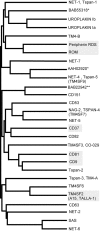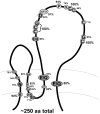Specific tetraspanin functions
- PMID: 11756464
- PMCID: PMC2199333
- DOI: 10.1083/jcb.200108061
Specific tetraspanin functions
Abstract
Relatively little attention has been given to the large family of abundantly expressed transmembrane proteins known as tetraspanins. Now, the importance of tetraspanins is strongly supported by emerging genetic evidence, coupled with new insights into the biochemistry and functions of tetraspanin protein complexes.
Figures


Similar articles
-
Genomewide analysis of the Drosophila tetraspanins reveals a subset with similar function in the formation of the embryonic synapse.Proc Natl Acad Sci U S A. 2002 Oct 15;99(21):13663-8. doi: 10.1073/pnas.212511099. Epub 2002 Oct 7. Proc Natl Acad Sci U S A. 2002. PMID: 12370414 Free PMC article.
-
A genomic perspective on membrane compartment organization.Nature. 2001 Feb 15;409(6822):839-41. doi: 10.1038/35057024. Nature. 2001. PMID: 11237004
-
Expression and function of transmembrane-4 superfamily (tetraspanin) proteins in osteoclasts: reciprocal roles of Tspan-5 and NET-6 during osteoclastogenesis.Allergol Int. 2007 Dec;56(4):457-63. doi: 10.2332/allergolint.O-07-488. Epub 2007 Nov 1. Allergol Int. 2007. PMID: 17965585
-
Tetraspanin 7 and its closest paralog tetraspanin 6: membrane organizers with key functions in brain development, viral infection, innate immunity, diabetes and cancer.Med Microbiol Immunol. 2020 Aug;209(4):427-436. doi: 10.1007/s00430-020-00681-3. Epub 2020 May 28. Med Microbiol Immunol. 2020. PMID: 32468130 Review.
-
Tetraspanin proteins as organisers of membrane microdomains and signalling complexes.Cell Signal. 2003 Jun;15(6):559-64. doi: 10.1016/s0898-6568(02)00147-x. Cell Signal. 2003. PMID: 12681443 Review.
Cited by
-
Tetraspanin15 regulates cellular trafficking and activity of the ectodomain sheddase ADAM10.Cell Mol Life Sci. 2012 Sep;69(17):2919-32. doi: 10.1007/s00018-012-0960-2. Epub 2012 Mar 25. Cell Mol Life Sci. 2012. PMID: 22446748 Free PMC article.
-
EWI-2 is a new component of the tetraspanin web in hepatocytes and lymphoid cells.Biochem J. 2003 Jul 15;373(Pt 2):409-21. doi: 10.1042/BJ20030343. Biochem J. 2003. PMID: 12708969 Free PMC article.
-
Anti-CD63 antibodies suppress IgE-dependent allergic reactions in vitro and in vivo.J Exp Med. 2005 Feb 7;201(3):385-96. doi: 10.1084/jem.20042085. Epub 2005 Jan 31. J Exp Med. 2005. PMID: 15684326 Free PMC article.
-
Large extracellular loop of tetraspanin as a potential vaccine candidate for filariasis.PLoS One. 2013 Oct 11;8(10):e77394. doi: 10.1371/journal.pone.0077394. eCollection 2013. PLoS One. 2013. PMID: 24146990 Free PMC article.
-
Tetraspanin CD9: A Key Regulator of Cell Adhesion in the Immune System.Front Immunol. 2018 Apr 30;9:863. doi: 10.3389/fimmu.2018.00863. eCollection 2018. Front Immunol. 2018. PMID: 29760699 Free PMC article. Review.
References
-
- Angelisova, P., I. Hilgert, and V. Horejsi. 1994. Association of four antigens of the tetraspan family (CD37,CD53, TAPA-1 and R2/C33) with MHC class II glycoproteins. Immunogenetics. 39:249–256. - PubMed
-
- Berditchevski, F., E. Gilbert, M.R. Griffiths, S. Fitter, L. Ashman, and S.J. Jenner. 2001. Analysis of the CD151-α3β1 integrin and CD151-tetraspanin interactions by mutagenesis. J. Biol. Chem. 276:41165–41174. - PubMed
-
- Boucheix, C., G.H.T. Duc, C. Jasmin, and E. Rubinstein. 2001. Tetraspanins and malignancy. (January 31, 2001) Expert Reviews in Molecular Medicine. http://www-ermm.cbcu.cam.ac.uk/01002381h.htm. - PubMed
Publication types
MeSH terms
Substances
LinkOut - more resources
Full Text Sources
Other Literature Sources
Molecular Biology Databases

